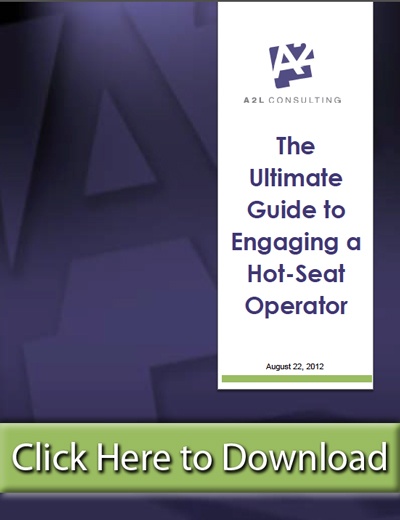It’s a phenomenon that I’ve seen countless times – renowned first-chair trial lawyers seeking to maintain hands-on control of their trial presentation by literally holding on to the clicker. Unfortunately, despite these lawyers’ sometimes desperate efforts to keep control, something almost always goes wrong in these situations.
For example, lawyers can lose track of their place and get ahead of their presentation in PowerPoint or another form of presentation software. They can try to go back a slide or two and find that they can’t get back. They can even click around so wildly that they crash the software during an opening statement.
As one can imagine, these scenarios can lead to a cascading meltdown for the presenter, who can become increasingly flustered. I’ve seen trial lawyers stop using their presentation software just because of an unanticipated “clicker crisis.” This level of crisis can be highly destabilizing for the lawyer’s team, as the lawyer’s frustration can spill over to the judge and jury. It can cause an immediate lack of credibility. At the very least, it can create distance between the trial team and the judge or jury, just at the moment when the team should be building rapport.
The solution is remarkably simple. In a recent article, I wrote about Israeli Prime Minister Benjamin Netanyahu’s presentation concerning Iran’s nuclear capabilities. If you watched Netanyahu for even a few seconds, you noticed that he wasn’t controlling a clicker. He looked prepared, confident and convincing – and one reason for that is that he used the political equivalent of a trial tech or hot-seat operator to take charge of the clicker.
Interestingly, doing it this way entails a higher degree of preparation than insisting upon full clicker control. Just as a person can never be sure that she understands a subject until she is able to teach it to another person, one doesn’t know a subject perfectly until she can teach someone else to run a presentation about it.
Soon will be gone, I hope, the days in which first-chair lawyers sit alone in hotel suites, practicing their opening statements with nothing but a typed draft and a glass of club soda, under the mistaken belief that their solitude will lead them to look more spontaneous. Unfortunately, these lone-wolf lawyers who leave their team out of their preparation generally come off as ill-prepared and unpracticed.
Netanyahu, on the other hand, came across as poised, comfortable and sincere, with a patina of spontaneity covering over a great deal of careful preparation.
That is not to say that a trial attorney should never practice on his own. It can be important, for example, to practice one’s body language so that he does not appear to be just sitting and reading a statement from a desk or lectern. And there may be carefully selected moments when a hand-off of the clicker from trial tech to attorney may draw the jury’s interest to a highlight of the opening statement. But even this must be carefully rehearsed.
Like any technology, the clicker introduces one more thing that can go wrong. The odds that something will go wrong are much greater when an attorney is handling the clicker rather than a trial tech who has used it in hundreds of previous trials. Clickers can fail for other reasons as well: failures of connectivity, battery loss or interference from other devices in the courtroom. Again, it’s better off to leave the attorney to practice law and not to deal with these potentially frustrating and even disastrous glitches.
So drop the clicker, hire a trial tech, and be as professional as possible.
Other free articles from A2L Consulting about trial technology, the use of hot-seat operators, and courtroom presentation issues include:
- What a Great “Hot Seat Operator” Can Add to a Trial Team
- What Does Using a Trial Technician or Hot-Seater Cost?
- Conflict check/availability of a trial technician. Completely Confidential.
- 12 Tips to Hire the Right Trial Technician for Your Trial
- Practice, Say Jury Consultants, is Why Movie Lawyers Perform So Well
- 12 Ways to Avoid a Trial Technology Superbowl-style Courtroom Blackout
- The 12 Worst PowerPoint Mistakes Litigators Make
- 5 Problems with Trial Graphics
- Why Trial Tech ≠ Litigation Graphics
- Why Rapport Between a Trial Lawyer and a Trial Technician is So Important
- 5 Tips for Displaying Documents Well at Trial [CVN Video]
- 5 Trial Director Techniques for Seamless Trial Presentations
- Trial Presentation Too Slick? Here's Why You Can Stop Worrying
- 12 Ways to SUCCESSFULLY Combine Oral and Visual Presentations
- 16 PowerPoint Litigation Graphics You Won't Believe Are PowerPoint
- The 14 Most Preventable Trial Preparation Mistakes
- 11 Traits of Great Courtroom Trial Technicians
- Making Good Use of Trial Director & Demonstratives in an Arbitration
- 7 Things You Never Want to Say in Court
- 3 Styles of Document Call-outs Used at Trial
- 5 Tips for Using TrialDirector and Trial Technicians Effectively
- Today's Tech Failure at the George Zimmerman Trial Takes Center Stage
- 8 Trial Technician-Related Tips for Midsized Law Firms






Leave a Comment